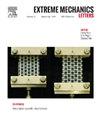Force-biased chemical degradation in rubbery networks: Insights from discrete network simulations
IF 4.5
3区 工程技术
Q2 MATERIALS SCIENCE, MULTIDISCIPLINARY
引用次数: 0
Abstract
This study investigates the effect of force-assisted chemical reaction leading to chain scission on the mechanical and swelling behaviour of rubbery networks. A Discrete Network (DN) modelling approach is adopted, in which polymer chains are represented as entropic springs connected at crosslink points. Force-accelerated chain scission is simulated using a Kinetic Monte Carlo algorithm. The model further accounts for degradation-induced swelling due to solvent uptake and mass loss due to the release of chain clusters detached from the main network. Discrete Network simulations highlight the role of force heterogeneities on the degradation of mechanical properties. Chains bearing the largest forces are cut preferentially, which accelerates the reduction in modulus and loss of percolation. When degradation occurs under constraint, force-biased degradation leads to anisotropic residual elastic properties. These effects cannot be captured by a state-of-the-art micromechanics-based continuum model, which does not account for the redistribution of forces through the network. Overall, the discrete network framework provides a promising platform to study a broader range of mechano-chemical phenomena in elastomers and gels.
橡胶网络中的力偏化学降解:来自离散网络模拟的见解
本研究探讨了导致链断裂的力辅助化学反应对橡胶网络的机械和膨胀行为的影响。采用离散网络(DN)建模方法,将聚合物链表示为在交联点连接的熵弹簧。采用动力学蒙特卡罗算法对力加速断链进行了仿真。该模型进一步解释了由溶剂吸收引起的降解引起的溶胀,以及由脱离主网络的链簇释放引起的质量损失。离散网络仿真突出了力的非均质性对机械性能退化的影响。承受最大力的链条被优先切断,这加速了模量的降低和渗透的损失。当退化发生在约束条件下时,力偏性退化导致材料的残余弹性性能各向异性。这些影响不能被最先进的基于微观力学的连续体模型所捕捉,因为它不能解释通过网络的力的再分配。总的来说,离散网络框架为研究弹性体和凝胶中更广泛的机械化学现象提供了一个有前途的平台。
本文章由计算机程序翻译,如有差异,请以英文原文为准。
求助全文
约1分钟内获得全文
求助全文
来源期刊

Extreme Mechanics Letters
Engineering-Mechanics of Materials
CiteScore
9.20
自引率
4.30%
发文量
179
审稿时长
45 days
期刊介绍:
Extreme Mechanics Letters (EML) enables rapid communication of research that highlights the role of mechanics in multi-disciplinary areas across materials science, physics, chemistry, biology, medicine and engineering. Emphasis is on the impact, depth and originality of new concepts, methods and observations at the forefront of applied sciences.
 求助内容:
求助内容: 应助结果提醒方式:
应助结果提醒方式:


